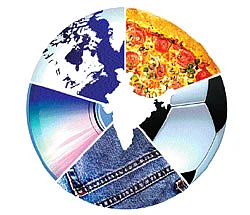
Indian culture is in peril; if things go on this way, our ancient heritage will be lost. Every few years, as a new generation of children — more true in urban areas — come of age, this cry is heard floating over the excitement of their young lives. In our time, my generation had heard it too as we took to the music and fashion flying out from the centres of popular arts in the western world with youthful enthusiasm. Blue jeans and Rock and Roll, Abba and the Dire Straits, Grateful Dead and Led Zeppelin; these had been the mantras of our generation. Why only music, in literature and poetry and fairy tales too, we sought out the exotic and salivated over scones and crumpets and dreamt of moonlit nights spent on a Faraway Tree in an Enchanted Forest. Did this innocent dabbling endanger the strong, vibrant local culture we were immersed in day to day? In the final reckoning, probably not, for we grew up to read Tagore and Biren Bhattacharya; draped ourselves in traditional silks on every auspicious occasion and cooked the family favourites handed down in an unbroken line through generations.
Indian culture is a many splendoured thing. No one thing — a particular style of music or cuisine — can lay claim to it; it is a vast ocean created by the mingling of innumerable iridescent streams: different and sometimes contrary styles of cooking; wildly different costumes and equally antagonistic belief systems and at the same time, a paradoxical sense of sharing something at the core of it all. A system of shared values that holds in high regard reverence to elders, duty to community and nation, and great pride in the heritage handed down by our ancestors, the arts and crafts honed to perfection over the centuries; this is the lynch pin of our culture. And it is a robust thing indeed, something we believe is capable of holding its own against any outside attack.
Is our culture truly impervious to erosion from foreign influences? While this has been mostly true in the last century, the turn of this century has seen something unprecedented happen. Distances, both in geographical terms and in real time, have been compressed to almost nothing. At the press of a button, one is instantly able to not only talk to a friend having breakfast on a farm in Scotland, one can see her too, as she digs into her Weetabix. As soon as a new music video is released on the west or east coast of the United States, it wings its way to our shores. No longer do children moon around record shops admiring records that were a few seasons old; in our days, only a lucky few, with family abroad, had direct access to brand new sparkly records. And football.
Football is the new religion of this generation of youngsters. Friendships are cemented on the basis of English Football Club affiliations; a Chelsea fan is an instant mate of another supporter; the fans dress in the team jerseys that cost the Indian parents exceedingly high amounts of money, and they worship at the altars of the young men who are the stars of these premier teams. Young girls step out of their homes dressed exactly like the young girls in London, New York, Brisbane or Cape Town. When they get together, young people eat exactly the same food they would eat at these great cities: pasta, burgers, escalopes and fish and chips. At a quick glance, our culture seems to be under an unexpectedly overwhelming attack. The outcome is uncertain, this time.
Imperilled entities
On closer scrutiny, however, having turned over stones, rocks and boulders, a different picture emerges from the one on the surface. The music ensemble of a school sings western songs, their young voices soaring with exultation, in a national choral music meet and in the blink of an eyelid, perform a few days later in an Indian music gathering.
With no sense of dislocation, the children switch between two languages and two disciplines of singing, enriching both with their natural vitality. The boy, dressed in the image of a rapper in Harlem, has been taking Indian classical music lessons since he was six; in a few years, he will be able to perform on stage and delight the audience with meticulous renderings of our ancient ragas. Some other young musicians have gone a step further; they have melded the rhythms of our folk traditions — music that is eminently suitable for this experiment because of its foot-tapping beats — with popular western music and injected a new life into art forms that otherwise ran the risk of falling into inevitable decline.
Which one of us has not tapped a finger or a toe to the vibrant beat of the modern versions of bhangra and now, joining that celebration are other regional variations: earthy Tamil folk music belted out to the accompaniment of the mridangam, Bengali boy bands who laugh at, poke fun at, but eventually embrace their complex society, and the Assamese singer, steeped in the classical traditions of his parents but choosing to bring to an adoring audience the insistent beat of bihu backed up by electronic music.
On the heels of the food of life, another imperilled entity, seemingly, is our cuisine. Stones were hurled through the shiny glass windows of American Fried Chicken stores; mothers stood, rolling pins in hand, determined to defy the advances of foreign burgers, but really, do we have to work ourselves into such degrees of excitement? In homes around the country, quietly, without protest, in fact, with delicious acceptance, the nation tucks into its traditional fare every day. In Punjab, rajma-chawal still reigns and the burger is no match for tandoori chicken. In fact, it is heard that in foreign countries, chicken tikka masala has routed the local cuisine and has accordingly been elevated to the status of National Dish. Dhokla, sweet daals, undios still excite Indian palates and to end a meal what better dishes than halwa, rosogollas and rabri? The same lentils, cooked in radically different ways and seasoned with condiments as diverse as amchoor and panch phoron and imli, simmer gently in every Indian home every night. There is little worry that our food heritage is in any danger of being annihilated.
Our literary tradition is another bastion that has sometimes been perceived as under threat. As English grew in strength, apprehensions grew that this upstart foreign language would render regional literature meaningless and irrelevant. A curious thing has happened over the years. Younger writers who wrote mainly in English achieved a remarkable coup; they transformed English into yet another Indian language and one with many different, richly flavoured regional dialects. The writer in Punjab adopted a vigorous English, bringing forth the smells and colours of vibrant Punjab; writers from Maharashtra, Rajasthan, Delhi and further afield, in the south of India, seasoned their writings with their own particular sensibilities and a very new breed of writers from the remote north-east of India brought to the rest of the country a subtle sense of dislocation and separateness of their existence by writing in an English that was as understated and gracious and redolent with beauty as their troubled region was. These writers enhanced Indian literature, adding to its already vibrant aesthetic. And simultaneously, to set worried minds completely at rest, there has been a flood of translations from the regional languages. Mainstream publishers regularly put out these brilliant books and all is well in our literary segment.
Convenience rules
But, what of the fashion eddying all around us today? Jeans, jeans and more jeans, no longer blue but in all hues of the rainbow; skinny jeans and boot-cut ones, full body curves and demi curves; knee length ones and ankle length ones. Jeans are everywhere.
And why not? They are comfortable and practical and if one can convince the young people to wash them at least once every six months, very flattering too. There is little sense in condemning something for the sake of it, especially when the young ones have the discernment to shed them when necessary. Consider our festivals. To match the mood of our festivals, young people turn out in beautifully appropriate costumes.
Onam brings our bevies of girls dressed in the gleaming ivory and gold of their home state; Diwali is celebrated with swathes of brilliant silks while Rongali Bihu in Assam is the signal for girls to wrap the gorgeous muga mekhela sador around themselves and pin kopu orchids into their hair. At a deeper level, many young men and women have delved further into this aspect of our culture: young textile and fashion designers are researching the rich textiles of their regions and helping bring about an unexpected renaissance. So, Eri from Assam is being fashioned into high fashion garments in Bangalore and the intricate weaves of Nagaland are making their way down runways.
Chikankari is now recognised across the world and the gossamer thin maheswaris adorn many a dress as an accompanying stole. No crisis in this area definitely.
This country has a long history of absorbing the best of foreign influences and weaving them into our culture. Consider the gardens of Mughal buildings, best exemplified in the Taj Mahal, the structure of the garden in front, with its water bodies and lines of trees, a faithful replica of older Persian gardens; regard the motifs of narcissi and irises in the block prints of Rajasthani and Gujarati textiles, regions that have never been witness to the flowering of these temperate beauties; listen again, to poetry that has travelled from the lands further west and taken root in our soil and it is abundantly clear that Indian culture will never be extinguished. It will only grow richer and more vibrant as it absorbs new ideas, seamlessly making them its own.

